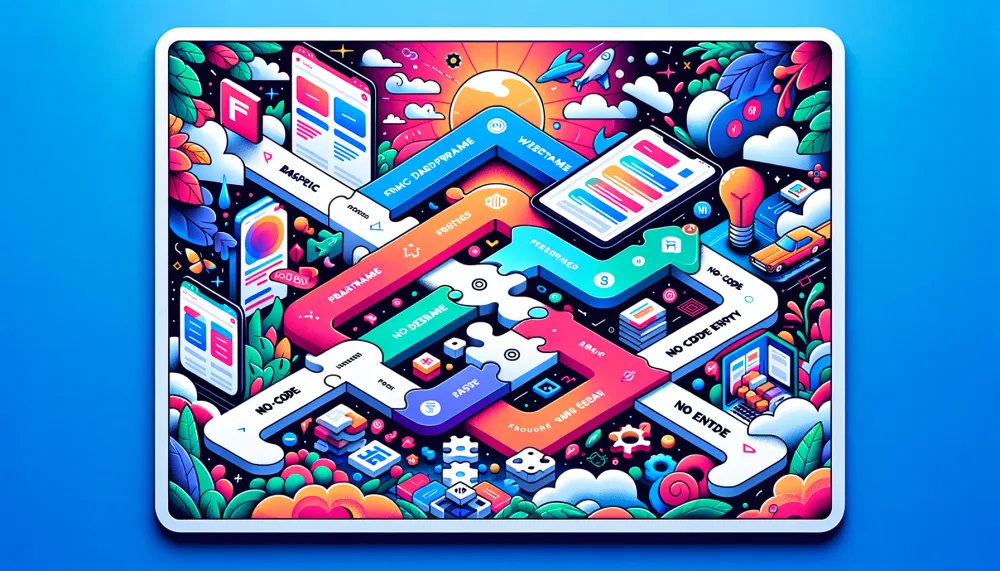The emergence of artificial intelligence (AI) has empowered us to craft customized user experiences that cater to the unique needs and preferences of individuals.
This level of personalization transcends static responses, allowing for intelligent interactions that evolve in response to user behavior patterns.
Note: Below are the links to other articles from this series:
How AI Systems Learn from User Behavior
Artificial Intelligence (AI) systems learn from user behavior through a process called machine learning. This process involves training an AI model on a large dataset of user interactions, allowing the model to identify patterns and make predictions about future user behavior.
For instance, Instagram's Explore recommender system uses AI to understand what content users are interested in and provide personalized recommendations. The system learns from users' past interactions, such as the posts they've liked, shared, or saved, and uses this information to predict what other content they might find interesting.
Similarly, Airbnb uses machine learning to understand host preferences and provide personalized recommendations to its users. The system learns from hosts' past interactions, such as the types of guests they've accepted or rejected, and uses this information to predict what other guests they might prefer.
Another example is Duolingo, a language learning platform that uses AI to personalize its lessons based on user behavior. The system learns from users' past performance, such as the types of exercises they struggle with or excel at, and uses this information to tailor future lessons to their needs.
These are just a few examples of how AI systems learn from user behavior. In each case, the AI model is trained on a dataset of user interactions, allowing it to identify patterns and make predictions about future user behavior. This process is fundamental to creating personalized user experiences, as it enables the system to adapt to each user's unique needs and preferences.
Types of Data Used for Personalization
In the realm of AI-driven user experiences, data is the fuel that powers personalization. By understanding the various types of data that can be harnessed, businesses can tailor experiences that resonate deeply with their users. Here's a breakdown of the primary data types leveraged for personalization:
- Behavioral Data:
- Description: This encompasses the actions users take while interacting with a product or platform. It includes clicks, scrolls, time spent on pages, and more.
- Example: E-commerce platforms analyzing which products a user views or adds to their cart to recommend similar items.
- Demographic Data:
- Description: Information about users' age, gender, location, occupation, etc. This data provides a broad understanding of who the user is.
- Example: A streaming service suggesting movies based on the age group and location of the user.
- Transactional Data:
- Description: Details about users' purchases, subscription history, and other transaction-related activities.
- Example: Online stores offering discounts to users who have previously purchased certain items.
- Feedback and Ratings:
- Description: Direct input from users about their preferences, likes, and dislikes.
- Example: Music streaming platforms using song ratings to curate personalized playlists.
- Social Media Data:
- Description: Insights gathered from users' social media activity, including likes, shares, and follows.
- Example: Brands analyzing users' social media activity to tailor marketing campaigns.
- Device and Technical Data:
- Description: Information about the devices users are accessing the platform from, their operating systems, browser types, etc.
- Example: Adapting the user interface based on whether the user is on a mobile device or desktop.
- Contextual Data:
- Description: Data about the current situation of the user, such as their current location, weather conditions, or time of day.
- Example: A food delivery app suggesting restaurants that are currently open based on the user's location and time.
Harnessing these diverse data types allows businesses to craft experiences that are not just generic but are finely tuned to each user's unique preferences and context.
All this while handling data responsibly and ensuring user privacy and trust are maintained.
In the next section, we'll talk about the importance of maintaining user privacy and the challenges that come with it.
Maintaining User Privacy
When taking about user data and personalization, we inevitably arrive at the doorstep of a topic that's as sensitive as it is crucial - user privacy. It's a subject that's been at the forefront of countless discussions, debates, and even controversies.
With that said, we're not diving into the deep and murky waters of the privacy debate.
Instead, we're focusing on a specific aspect that allows us to balance personalization and privacy - the use of anonymous data. By anonymizing data, we can still provide personalized experiences without infringing on the user's privacy.
Let's focus on how anonymous data can be used to enhance user experiences, while maintaining a respectful distance from the user's private information. Again, we're not ignoring the importance of privacy, but rather acknowledging it by focusing on practices that respect and uphold it.
Here are some key points from the articles that discuss the positive aspects of using anonymous user data and how it can improve user experiences:
- The Benefits of Anonymous Data: Anonymous data can be used to improve user experiences by providing personalized recommendations and services. For example, a music streaming service can suggest songs based on the listening habits of similar users. This can make the service more engaging and useful for the user.
- How Anonymized Data Contributes to Data Privacy: Anonymized data can be used for research and development purposes. For instance, in healthcare, anonymized patient data can be used to identify trends, improve treatments, and advance medical research. This can lead to better healthcare outcomes for patients.
- The Power of Anonymized Data: Anonymous data can help businesses understand their customers better, leading to improved products and services. For example, a business can analyze the shopping habits of its customers to identify popular products and trends. This can help the business stock the right products and improve its sales.
- The Promise and Peril of Anonymized Data: While there are concerns about the potential misuse of anonymized data, it can also be used for public good. For example, anonymized data can be used to track the spread of diseases, helping public health officials make informed decisions.
- How Anonymous Data Can Be a Powerful Tool for Reducing Bias: Anonymous data can help reduce bias in decision-making processes. For example, in hiring, anonymized applicant data can help employers focus on the qualifications of the candidates, rather than their personal characteristics.
In conclusion, while maintaining user privacy is paramount, the use of anonymized data can lead to improved services, better research outcomes, and more informed decision-making. It's a delicate balance that requires careful management and robust data privacy measures.
Real-World Examples of Tailored User Experiences
Shopify's AI-Powered Shopping Assistant: Sidekick
Shopify, a leading e-commerce platform, has been at the forefront of leveraging AI to enhance the shopping experience for both merchants and customers. Their recent introduction of the AI assistant, named "Sidekick," is a testament to their commitment to harnessing the power of AI for e-commerce.
How Sidekick Works:
- Personalized Recommendations: Sidekick uses AI algorithms to analyze user behavior and preferences, offering product recommendations tailored to individual shoppers. This ensures that customers are presented with items that align with their tastes and shopping history.
- ChatGPT for E-commerce: Drawing parallels with the advanced AI model ChatGPT, Sidekick acts as a conversational interface for merchants. It assists in answering customer queries, providing product details, and even handling basic customer service tasks.
- Empowering Entrepreneurs: For small business owners and entrepreneurs, Sidekick acts as a virtual assistant, helping manage their online store more efficiently. From inventory management to customer interactions, Sidekick streamlines various e-commerce processes.
Benefits for Merchants and Shoppers:
- Enhanced User Experience: With Sidekick, shoppers no longer have to sift through countless products. The AI-driven recommendations ensure a more curated shopping experience.
- Increased Sales: Personalized product suggestions mean that customers are more likely to find what they're looking for, leading to higher conversion rates and increased sales for merchants.
- Efficient Customer Service: By handling routine queries and tasks, Sidekick allows merchants to focus on more complex customer service issues, ensuring faster response times and higher customer satisfaction.
In Conclusion: Shopify's Sidekick is a prime example of how AI can be seamlessly integrated into e-commerce platforms to offer a more personalized and efficient shopping experience. As AI continues to evolve, we can expect even more innovative solutions that reshape the way we shop online.
Honorable mentions:
- Hugging Face – ConvAI: This is a machine learning model that creates a consistent persona based on a few lines of bio. You can chat with this persona.
- ActiveChat.ai | Discover AI use cases: ActiveChat is a smart conversational AI platform with natural language understanding for customer support, e-commerce, and marketing chatbots. They have partnered with OpenAI to build something that looks like real magic.
- Welcome to LENS: This is a research demo of the LENS (LLMs ENhanced to See) system, which leverages a set of vision modules to describe images to an LLM. You can talk to LENS by uploading images and asking questions about them.
- Powering Talking Characters with Generative AI: Google’s Partner Innovation team has developed a series of Generative AI templates to showcase how combining Large Language Models with existing Google APIs and technologies can solve specific industry use cases.
- Powered by AI: Instagram’s Explore recommender system: This blog post provides a detailed overview of the key elements that make Instagram's Explore work, and how they provide personalized content for people on Instagram.
Wrapping Up
We've been talking about how AI is changing the game in design, specifically in creating personalized user experiences. We've seen how these smart systems are like detectives, picking up clues from user behavior and using those insights to tailor the experience just for them.
Key Takeaways:
- AI systems are like your personal concierge, learning from your actions and preferences to serve you better.
- They use all kinds of data, from your behavior to your profile information, to make this magic happen.
- Maintaining your privacy is a big deal, and these systems are designed to respect that.
- Shopify's Sidekick as an example IRL. It's a great example of how AI can transform the way we shop online.
I hope you've enjoyed this dive into AI-enhanced design as much as I have writing it. It's like opening a door to a whole new universe of possibilities.
Have you come across any other examples of AI-enhanced design? Do you have thoughts or questions about what we've covered?
Drop us a line Twitter. Just click here to share your insights.




